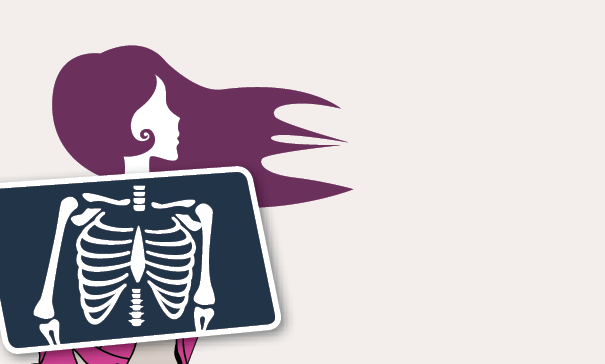Written by Karen Roodman
When we hear about osteoporosis, there seems to be ambiguity regarding the real meaning and seriousness of this silent disease.
The word osteoporosis literally means “porous bones.” It occurs when bones lose an excessive amount of protein and mineral content, particularly calcium. Over time, bone mass—and therefore bone strength—decreases. Bones become fragile and break easily. In severe cases, even a sneeze or sudden movement may be enough to break a bone. And although it is often considered an “older” person’s disease, the statistics are beginning to include younger sufferers, mainly because of poor nutrition and lack of exercise during early bone-building years.
“Osteoporosis is a silent disease because we do not know what is happening with our bones through development and maturity,” says Dr. Kristin Fabiato, an endocrinologist in the Richmond area who treats osteoporosis patients. She says many factors put people at risk for osteoporosis. These predispositions include being thin, Asian or Caucasian; having a history of smoking or alcohol abuse; and a family history of osteoporosis or fracture. Certain medications can also affect bone health. For example, steroids can relieve inflammation in conditions like rheumatoid arthritis or asthma but also have negative ramifications on bone integrity.
Dr. Jeffery Carlson, an orthopedic specialist in Newport News, treats the consequences of osteoporosis. By the time patients come to him with pain, they most likely have experienced a compression fracture. “These patients may or may not present with increased kyphosis, or pronounced rounding of the middle spine, but typically they do have postural clues that suggest a compression fracture,” he says.
It is protocol in Carlson’s practice, Orthopedic and Spine Center, to recommend bone densitometry for patients older than 50 years of age. Bone density scanning (also called dual-energy X-ray absorptiometry, or DXA), is an enhanced form of X-ray technology used to measure bone loss.
Dr. Kieran Cross, director of radiology at HCA Retreat Doctors’ Hospital in Richmond, describes the DXA scan as painless and quick.
“We encourage all women over 50, and men over 70 to have this test completed,” Cross says. For women who are post-menopausal, the estrogen loss resulting from menopause impacts bone, and for this reason alone anyone in this demographic is encouraged to get a DXA scan.
The values that a DXA test produces are expressed as ‘T’ scores and ‘Z’ scores. ‘T’ scores indicate the amount of bone loss by quantifying the difference between bone mineral density at one’s current age and the peak bone mass for a normal population (age 30). ‘T’ scores are commonly used to make the diagnosis for osteoporosis.
‘Z’ scores indicate one’s bone mineral density values by assessing the amount of bone compared with age-like peers, as well as predicting the risk of fracture.
What about osteopenia, or a pre-osteoporotic stage with ‘T’ scores hovering at below-average values? Doctors say we shouldn’t take this diagnosis lightly but instead take steps to preserve and strengthen the bones.
First, try weight-bearing exercise. Bones want to be challenged, and the key is to perform safe movements with good alignment and purpose. Some exercises are better than others. For instance, swimming, although easy on the joints, does not improve bone density. Resistance training, such as free weights or use of equipment that employs resistance, is very effective. Pilates is a good choice because it helps to align joints so we move properly.
Choose foods rich in calcium and vitamin D, which are essential for building and maintaining bone. Ask your doctor if a supplement is right for you.
Prescription medications can also help. There are a number of osteoporosis medications on the market and your doctor will consider factors such as the severity of your condition, compliance factors and gastrointestinal tolerance before prescribing one. Intestinal distress can be a side effect from drug therapy, inspiring the development of injected medications that bypass the stomach. This new wave of medication is still under study but appears promising.
Regardless of our genetics, we need to eat well, move well and take steps to optimize our health. Be proactive with proper nutrition, mineral supplementation and weight-bearing exercise, and you can build your bone health.
STAT: 1 in 2 women older than 50, and 1 in 4 men older than 70, will develop osteoporosis.
For more information on osteoporosis, visit:
www.nof.org (National Osteoporosis Foundation)
www.americanbonehealth.org (American Bone Health)
www.asbmr.org (American Society for Bone and Mineral Research)

